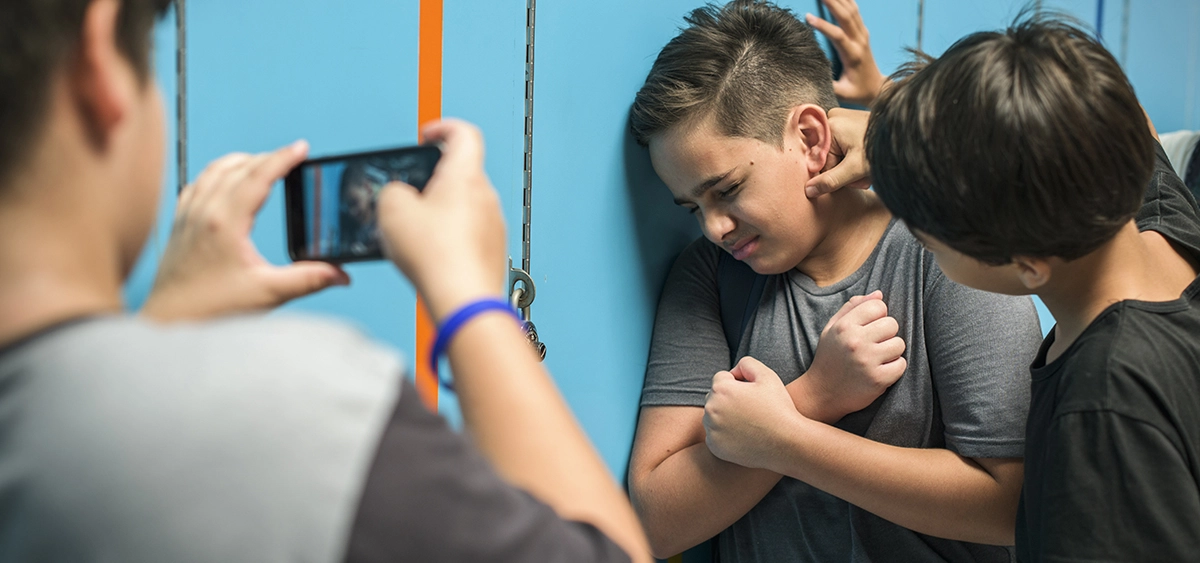Schools are obliged to take action to prevent bullying and violence. Also, there can be serious consequences for those who bully or are violent. As a victim or a parent, how can you recognize bullying or violence at school? What support services are available?

Bullying
For Quebec schools, the law defines bullying as including these elements:
- repeated actions or words
- the behaviour excludes or hurts the victim and makes the victim feel powerless
- there is a power imbalance between the person who bullies and the victim
Behaviour that includes these elements is bullying even if the person who bullies does not intend to cause harm.
Behaviour can be bullying even if the victim is not present. For example, a person who bullies could say hurtful things about the victim to someone else, and the victim could find out about it later. Bullying can also take place over the Internet. It’s called cyberbullying.
Violence
For Quebec schools, the law defines violence as the use of force against someone. Unlike bullying, violence is always intentional. It can be
- verbal or written,
- physical,
- psychological, or
- sexual.
Violence can be used against people or their property.
Real-life examples of bullying and violence at school
Here are some real examples of bullying and violence at school.
- A student was called ugly and insulted her in other ways. Other students threw objects at her and hit her with a lunch box.
- A student is called names and ridiculed in front of others. Her books are thrown on the ground. The student is threatened with physical violence. Water is thrown at her.
- A student has her hair pulled and is called names. Other students hide her belongings. Threatening notes are left in her desk. She is punched in the chest and face. She is cornered in the washroom and touched inappropriately.
Schools must act
Plan to prevent and stop bullying
The law requires every school to have a plan that includes steps to prevent and stop bullying and violence towards a student, a teacher or any other school staff member.
The plan must include these things:
- steps to prevent bullying
- a procedure for reporting cases of bullying
- measures to make sure complaints remain confidential
- the action to be taken against bullies when bullying is reported by a student, teacher, friend, etc.
- ways to support victims or witnesses of bullying or violence
The plan must be sent to the parents. Also, students must be given training on bullying and told what action will be taken against students who bully others. Actions can be taken against students whether they are bullying other students or any other school staff member.
Role of school employees
School employees must protect students from violence and bullying.
Public school principals must receive complaints of bullying and violence, and then let the parents know.
In a private school, a member of the board of governors must promptly tell the parents when bullying or violence is reported and explain what action will be taken.
Consequences for students who bully others
The school’s plan against bullying and violence must also include the action to be taken against students who bully others or are violent. The action depends on how serious the behaviour is. It can include detention, a letter of apology, suspension and even being expelled from the school.
|
Important! Serious acts of bullying or violence can be crimes. In these cases, the police might get involved. |
Victims: getting help
Students being bullied can talk to their parents, friends, teachers and school support staff. Once school employees are aware of a situation, they have a duty to help and to put into practice the plan to prevent and stop on bullying.
Students can also contact support organizations such as Kids Help Phone and Tel-jeunes.
Complaints against a school’s decision
Students or their parents can file a complaint if they feel that the student’s rights have not been respected. For example, a student accused of bullying or violence could complain that action was taken against them before they had a chance to explain. Or a victim could complain that the school didn’t act quickly enough to stop bullying or violence.
Here’s who to turn to in order to file a complaint:
- First, to the teacher or school support staff who handled the situation or their immediate superior.
- If this doesn’t work or if the complaint isn’t processed within 10 working days, other options are available. For public schools, the student or parent could turn to the person in charge of processing complaints at the school service centres or school board level. For private schools, they can go to the person in charge of processing complaints within the school.
- If the student or parent is dissatisfied with the result, or if the complaint isn’t processed within 15 working days, they can turn to the regional student ombudsman.
Anyone may report an act of sexual violence to the regional student ombudsman.
The school, school service centre or school board cannot retaliate against a person who makes a complaint or a report. For example, they are not allowed to suspend a student, expel them or deprive a student or their parents of their rights.
Victims of bullying may also sue the school and school service centre (or school board) for damages suffered.





